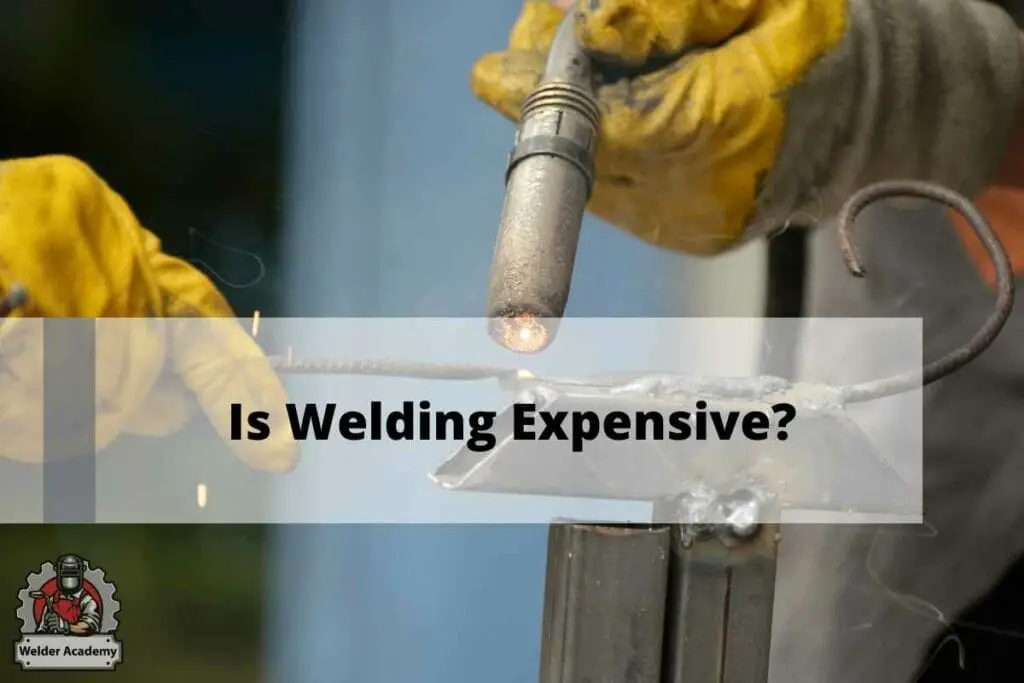Welding has been around for centuries. It’s a substantial part of our everyday lives. And our lives would be very different and, to be honest, quite uninteresting if we didn’t weld. But that doesn’t mean that this essential form of mechanics comes in cheap. Let’s talk about its affordability and finally conclude whether is welding expensive.
A welding job costs $340 in general. Small and simple tasks, on the other hand, can cost as little as a hundred bucks, while larger projects can cost thousands. The entire cost is determined by several factors, including costs of labor, materials, tools, and the type of welding.

Welding is a durable and sturdy approach for repairs around the house. It is also considered to be an extremely fun hobby or a newfound passion. Whatever may be your incentive, you should first make a budget for welding costs before you start with the whole process.
Various factors determine the cost of welding and we’ll evaluate some of them in this article. So, buckle up!
The Cost Breakdown of Welding
Welding is the process of joining two pieces of metal that have a strong bond, by melting them together to form a single, solid structure. Infrastructure construction, manufacturing, transportation, shipping, railroads, automobiles, and even aerospace aircraft aviation all require welding.
Welding is also for domestic chores such as repairing plumbing, building gates and fences, and fusing metal constructions. Welding is a basic concept; nevertheless, the actual cost of welding is complicated by a plethora of factors and options, including both fixed and variable expenses.
Let’s look at the initial fixed costs:
Preparation of the joints and preheating the materials is amongst the initial fixed expenditure. These costs will stay fixed no matter the level of increase in production. Other than that, tacking, fixing, clean-up and inspection also fall under the fixed costs for welding.
Now we have the variable costs:
If we consider the variable costs, we’ll need to look at welding techniques, filler types, average hourly wage, rate of overhead, and lastly the materials including power/fuel. These costs will vary with your increase in production.
When you’re deciding on how much to spend, it can be quite tempting to go for the cheapest option or alternative. But cheap does not necessarily mean better. You might be spending less in the initial stage. But the chances are that you might be getting the shorter end of the bargain with your rates.
If the, let’s say, materials are not of high quality, your welding will be poorly done. Now, this can cost you additional money in the long run. So be wary of that.
But I know it’s tempting to choose the most cost-effective alternative for each variable cost; but cost-effective choices are dependent on process efficiency, productivity improvement, and compatibility. More effective methods and materials may save you money in the long term, even if they are initially more expensive.
Labor Costs for Welding
Welding is not just a functional means of fusing metals. It is truly a form of extravagant art, and that is why labor costs are on the more expensive side and should be taken into consideration when hiring a professional.
Labor expenditures account for 60 to 70 percent of total project costs, although they can even go up to 85 percent in a few instances. And labor costs do not only include welding time, but pay a lot of heed to the time spent on preparing the supplies needed, preheating, the inspection, and clean-up.
The following factors have crucial impacts on labor costs:
- Deposition rate
- Wage per hour
- Total time spent on the operation
The majority of welders will charge you an hourly rate. On top of that, welders may charge a fee to compensate for their travel costs. Due to this reason, shifting transportable items straight to the location is a simpler approach if you want to save money.
With that being said, it’s no mystery that labor accounts for such a large portion of the total cost incurred. So, it may be worthwhile to take up welding as a new pastime. If you want to do a lot of welding jobs and have a lot of free time, there are welding methods that are beginner-friendly.
Cost of Supplies, Materials & Equipment
Each welding technique necessitates its very own range of tools and supplies. Some forms of welding demand a larger initial equipment investment but can save money over time by using less expensive materials or using a more efficient procedure.
The following items are essential in material costs: filler material, base metal, flux: a form of shielding gas, and sanding stones/grinding wheels.
The price range of the common materials may vary but, let’s have a look at some of the average prices for the different types of materials for welding.
- A 25 ft stick of 14-gauge steel will cost you around $44 to $125
- 1 bottle of flux/gas will be around $40 to $50
- A 30-pound roll of wire will be 40 dollars
- Finally, 25 sheets of sandpaper cost 16 dollars.
Most Expensive Type of Welding: TIG or MIG?
If we were to make a list of the most common types of welding, MIG and TIG will always be at the top. Not only are they more popular, but they’re also amongst the more expensive kind of welding. But if we were to pick between the two, TIG is comparatively more expensive. If I were to add, it’s considered to even be the most expensive of the top welding methods.
TIG welding falls under the arc welding process and uses a power supply to generate an electric arc between the base metal and the electrode.
After that, you only need to generate heat at the point of contact between those two positively charged electrodes and the negatively charged base material. Now as soon as they reach their melting point, both of them fuse in each other.
Out of all the arc welding processes, TIG is the most sophisticated and uses two-handed expertise. This allows the operator to use one of his hands to grip the torch while he uses the other one to feed a rod of filler material.
When it comes to the use of shielding gasses, TIG normally uses argon or helium. Now, these gasses come at a price and thus the whole process is not cheap. But even though the whole method is more expensive, using these gasses allows the welder to achieve higher temperatures.
But what if the heat is too high? That is when the welders use a foot pedal to manage the heat. Thus, allowing the welder to work with metals that are more fragile or delicate.
With all these characteristics of high heat capabilities, the ability to control that heat, and the overall versatility, it’s no wonder that the TIG welding process can be conducted on most metals.
Thus, this is also why TIG happens to be the most expensive out of most welding processes. So, if you’re hiring a welder who’s an expert in his craft and happens to use TIG welding, it will cost you more. TIG welding is complex so it’s not something that all welders can do. It requires time and expertise. And also, more expenses.
Conclusion
Welding prices are highly dependent on the type and scale of the project. With a thorough grasp of welding procedures and materials, you will be able to manage and minimize the expenses.
It’s important to realize that lower-cost options aren’t always superior, as the entire cost of a welding project is under the influence of a variety of factors.
The greatest approach to save money is to appropriately match welding parameters to project needs. So, at the end of the day, is welding expensive? It depends on several factors. Hopefully, this article helped you in your endeavor. Thank you for giving this a read. Have a great day!
